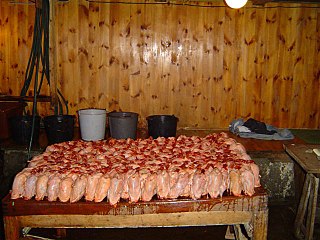Faroese puffin

Puffin is a culinary speciality of the Faroe Islands, in the North Atlantic Ocean. Atlantic puffins breed in the islands in large numbers, notably on Mykines, and from July, after the breeding season, it is legal to catch them for food. Puffins are also widely harvested and eaten in Iceland, especially in the Westmen Isles.
Puffin harvesting

In the summer months, the Faroes are home to about five million seabirds, including two million breeding pairs, with a biomass of 3,000 tonnes. Seabird harvesting in the Faroe Islands has been carried out sustainably for at least 300 years, historically forming a very important component of the Faroese diet. Bag limits are now set each year to maintain the harvest of tens of thousands of birds annually. Ownership of the areas where puffins, and other harvested seabirds, breed and are caught, may be by individuals or communally by villages. Puffins and fulmars are the most important species harvested, but guillemots and gannets (and, historically, other species) are also taken.[1][2]
Puffins are caught by the traditional method of "fleyging". This is catching the birds in flight by actively netting them with the hand-wielded "fleygingarstong", a 3.6 metre-long pole with a small net at the end suspended between two rods, somewhat like a very long lacrosse stick. Fleyging is usually carried out on a cliff-top from a "fleygises", or fleyging-seat, built of stones in a small depression so that the fleyger is concealed from overflying puffins. The puffins then have their necks snapped or their heads simply pulled off. Several hundred puffins may be caught in this way by one person in a day.[3]
Puffins in Faroese culture
Puffins are culturally important in the Faroe Islands. The Faroese word for puffin is "lundi". A popular and much loved Faroese cartoon character is the bespectacled puffin known as Ludvik Lundi.
Puffin in Faroese cuisine

The birds are traditionally prepared by being skinned, the feet, wings and internal organs removed, soaked in a simple marinade of saltwater, milk or ale, then browned in a pan or boiled. They are sometimes smoked before being cooked. More recently other methods, such as grilling the breasts, are being used. Puffins may also be stuffed with sweet cake dough, raisins and spices, before being boiled or roasted.[4]
References
- ^ Nørrevang, Arne. (1986). Traditions of sea bird fowling in the Faroes: An ecological basis for sustained fowling. Ornis Scandinavica 17: 275-281.
- ^ International Arctic Science Committee (Content Partner); Sidney Draggan (Topic Editor). 2007. "Management and conservation of marine mammals and seabirds in the Arctic." In: Encyclopedia of Earth. Eds. Cutler J. Cleveland (Washington, D.C.: Environmental Information Coalition, National Council for Science and the Environment).[1](Published in the Encyclopedia of Earth June 8, 2007; Retrieved 6 February 2009)
- ^ Mohr, Janus. (12 December 1979). About the fleyging (catching) of puffins on Mykines. Oyggjatiðindi 58.[2]
- ^ The Gastronaut: Puffin
